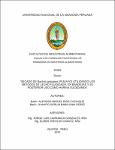Secado de bactris gasipaes (pijuayo) utilizando los métodos de lecho fluidizado, en bandejas y su posterior uso como harina sucedánea

View/
Date
2017Author
Ríos Cachique, Alfonso Miguel
Babilonia Pérez, Juanito Gerlin
Metadata
Show full item recordAbstract
El presente trabajo fue realizado en los ambientes de la planta de Conservas de Palmito y los Laboratorios de Análisis físico - químico de Alimentos de la Facultad de Industrias Alimentarias - UNAP.
El equipo empleado para secar las muestras fue un horno secador de lecho fluidizado con una temperatura de funcionamiento de 40 °C a 120 °C, también se utilizó un Anemómetro para medir la velocidad de aire circulante y un termohigrómetro para medir la temperatura y humedad relativa en el interior del horno y así asegurarnos que estas no varíen y se mantengan constantes durante las pruebas, estos equipos se utilizaron durante todo el tiempo de duración de la presente investigación.
La materia prima a emplear es proveniente de las comunidades de la provincia de Mariscal Ramon Castilla (Caballo cocha), teniendo como objetivo principal del presente trabajo de investigación realizar una serie de experimentos para la obtención de los parámetros de secado del Bactris gasipaes (pijuayo) y su posterior conversión en harina empleando los secadores de lecho fluidizado y bandejas.
Para una correcta deshidratación del fruto del pijuayo se seguirá el siguiente diagrama de flujo:
Materia prima, selección y eliminación del ápice, limpieza y desinfección, pre cocido, secado en horno secador de lecho fluidizado y de bandejas, molienda, tamizado, envasado y almacenado.
Se aplicó un análisis estadístico para validar el proceso de secado,fue el (ANOVA), el cual tenía el diseño factorial 23, representado por la ecuación:
Y = B0 + B1X1 + B2X2 + B3X3 + B4X1 X2 + B5X1 X3 + B6X2 X3 + B7X1 X2 X3, que tendrá tres factores: X1 = temperatura (°C), X2 = velocidad de aire (m/s), X3 = tamaño de la muestra (mm). El factor X1 tiene 2 niveles (-1 = 50 °C, +1 = 70 °C), el factor X2 tiene 2 niveles (-1 = 4 m/s, +1 = 6 m/s), El factor X3 tiene 2 niveles (-1 = 2 mm, +1 = 4 mm), con un rango de aceptación de R2 (> 85 por ciento) y el valor P
xii
(P< 0.05) ó (Fcal>Ftabla). El análisis estadístico concluyo que el contenido de humedad final depende únicamente del factor temperatura y no de la velocidad de aire.
Las concentraciones de humedad final fueron de 5.34 hasta 10.4 por ciento lo que indica que todos los tratamientos de temperatura son aceptables para su uso como harina ya que la harina comercial esta normada para tener un contenido de humedad de 10 -14 por ciento.
Los experimentos demostraron que los consumos de energía no difieren mucho entre ellos lo que sugiere que sería mejor trabajar a 70 °C porque ahorraríamos cerca del 42 por ciento de tiempo con su consiguiente ahorro de todo el proceso lo que involucra horas hombre de trabajo, energía, etc. Esta temperatura de 70 °C no afecta las propiedades físico químicas del Bactris gasipaes (pijuayo). The present work was carried out in the environments of the Conservas de Palmito plant and the Laboratories of Physical - chemical Analysis of Foods of the Faculty of Food Industries - UNAP.
The equipment used to dry the samples was a fluidized bed dryer with an operating temperature of 40 ° C to 120 ° C, an Anemometer was also used to measure the circulating air velocity and a thermohygrometer to measure the temperature and relative humidity inside the oven and thus ensure that these do not vary and remain constant during the tests, these equipments were used throughout the duration of the present investigation.
The raw material to be used comes from the communities of the province of Mariscal Ramon Castilla (Caballo cocha), having as main objective of the present research work to carry out a series of experiments to obtain the drying parameters of Bactris gasipaes (pijuayo) and its subsequent conversion into flour using the fluidized bed driers and trays.
For a correct dehydration of the fruit of the pijuayo will follow the following flow diagram:
Raw material, selection and elimination of the apex, cleaning and disinfection, pre-cooked, kiln dryer drying of fluidized bed and trays, grinding, sieving, packaging and storage.
A statistical analysis was applied to validate the drying process, it was the (ANOVA), which had the factorial design 23, represented by the equation:
Y = B0 + B1X1 + B2X2 + B3X3 + B4X1 X2 + B5X1 X3 + B6X2 X3 + B7X1 X2 X3, which will have three factors: X1 = temperature (° C), X2 = air velocity of the sample (mm). Factor X1 has 2 levels (-1 = 50 ° C, +1 = 70 ° C), factor X2 has 2 levels (-1 = 4 m / s, +1 = 6 m / s). 2 levels (-1 = 2 mm, +1 = 4 mm), with an acceptance range of R2 (> 85%) and P (P <0.05) or (Fcal> Ftabla). Statistical analysis concluded that the final moisture content depends only on the temperature factor and not on the air velocity.
xiv
Final moisture concentrations were 5.34 to 10.4% indicating that all temperature treatments are acceptable for use as flour since commercial flour is set to have a moisture content of 10-14%.
The experiments showed that the energy consumption does not differ much between them, suggesting that it would be better to work at 70 ° C because we would save about 42% of time with its consequent saving of the whole process which involves man hours of work, energy, etc. This temperature of 70 ° C does not affect the physical properties of Bactris gasipaes (pijuayo).
Collections
- Tesis [122]
The following license files are associated with this item:

